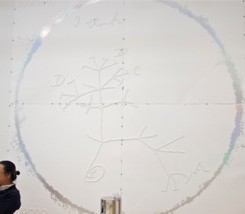“Time Travelers Chronicle (Doubt): 2014–802,701 AD”: exhibition by Rirkrit Tiravanija
Singapore Tyler Print Institute (STPI) (41 Robertson Quay, Singapore) May 24–June 28, 2014
One tends to think of food and relational art when thinking of Rirkrit Tiravanija, which is perhaps a little unfair, like the typecasting suffered by Boris Karloff. Despite acknowledging this, the notion of Tiravanija working alongside the Singapore Tyler Print Institute does elicit some sense of fascinated curiosity at what they’ve produced, particularly under a title like “Time Travelers Chronicle (Doubt): 2014-802,701 A.D.”
Much of the gallery is given over to a series of eight works, each of which consists of a massive print, a 3D printed object on a reflective, geometric plinth, and a gnomically evocative title. Each constitutes a chapter in Tiravanija’s time-traveling narrative, or perhaps a component in this notional time machine. The engine’s direction, in a sense, is supplied by numerals in relief in the corners of the prints, following the Fibonacci integer sequence.
The series tends towards a monochrome, space-age coolness, with most of the prints dominated by circular chrome surfaces that recall the insulating foils often seen on the outside of satellites and space probes, and the reflective plinths before each print seemingly on the verge of vanishing. The imagery flows from Darwin’s original sketch of a tree of life, on to a densely populated modern diagram of speciation, and then to more abstract interpretations of warped space and time before looping back on itself. At each turn, these markers of space and time have as a counterpoint some incongruous object atop a plinth—ghostly renditions of, say, a bowl of curry noodles, a Spongebob Squarepants figurine, or a Negroni cocktail, each offering a link to more personal histories and obsessions.
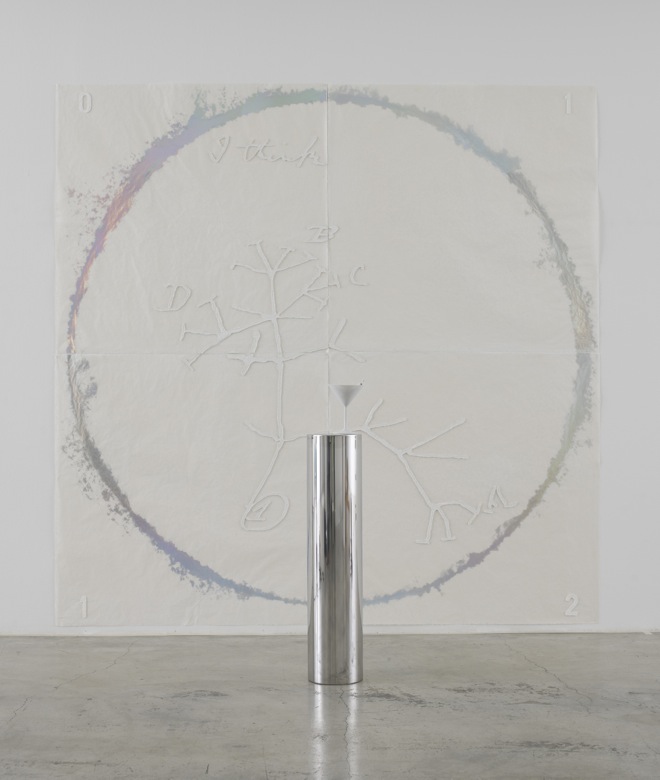
Rirkrit Tiravanija, “The tree of life, the eclipse and drink a Negroni to the future”, screen print, metal foil, cast paper, stainless steel pedestal, 3D printed object, paper: 269.4 x 269.5 cm (4 sheets), pedestal: 100.5 x 23 x 23 cm, object: 23 x 15.5 x 15.5 cm, 2013
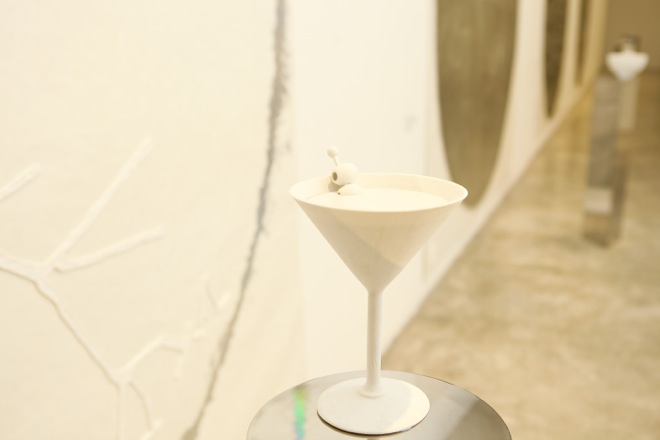
Rirkrit Tiravanija, “The tree of life, the eclipse and drink a Negroni to the future”, screen print, metal foil, cast paper, stainless steel pedestal, 3D printed object, paper: 269.4 x 269.5 cm (4 sheets), pedestal: 100.5 x 23 x 23 cm, object: 23 x 15.5 x 15.5 cm, 2013 (close up detail)
As a negotiation between Tiravanija’s practice and the serial nature of the printing process, the series exists in the ambiguous territory between singularity in multiplicity—monoprints, yes, but then again the images themselves are repeated, and yet the 3D printed objects, plinths, titles, introduce an additional degree of difference.
A different strategy might be found in “The Time Traveler’s Calendar: A Mental Map of the Unmappable”, in editions of eight, which at first appear to be little more than inky voids, marked here and there by pale hand-prints. Briefly touching one reveals their nature—the black ink is thermochromatic. Its opacity melts away as it reaches body temperature to reveal, like a lottery scratch-card, spiral diagrams based on the Fibonacci sequence. It’s a popular bit of mathematics for seekers of underlying truths and patterns in nature and the universe, but there’s a sense that Tiravanija is not so much joining this grand Snark hunt as leveraging its enduring fascination—an icon as potent as Elvis sightings or perpetual motion machines.

Rirkrit Tiravanija, “The time travelers calendar, a mental map of the unmappable”, screen print, thermochromatic ink, canvas, 132.5 x 132.5 cm, 2013 (edition of 8).
Taken together, the two series illuminate something of Tiravanija’s relationship with print—in each instance, there is no canonical form, no original point of stability. Both are intimately entwined, in a nod to his relational performances, to both their immediate environment and the people who come into contact with them—whether by subtle temperature differences yielding a different shade of black as in the thermochromatic prints, or different patterns of physical touch, or the foil-stamped prints and chromed plinths reflecting their ambient surroundings.
It is not that an original has been differentiated, but that differentiation itself can be multiplied, in a way that suggests that this heightened awareness of contextuality should apply beyond his works—after all, while these works by Tiravanija might change dramatically in appearance depending on their setting, so to are artworks in general engaged with some amount of dialogue with their surroundings.
His relationship with print aside, though, the show as a whole is suggestive of some line of succession from William Gibson’s dissection of pulp sci-fi’s gleaming utopias in “The Gernsback Continuum”, in which a writer encounters the semiotic ghosts of a 1980 that never was—zeppelins and improbably aerodynamic cars intruding into his perceptions, broken dreams of timelessly sterile modernist triumphalism. Here, through Spongebob, the roles are reversed—an aperture into a chromed world of obsessive, ironic, fractured temporality hovering on the edges of our drably quotidian, linearly functionalized time.
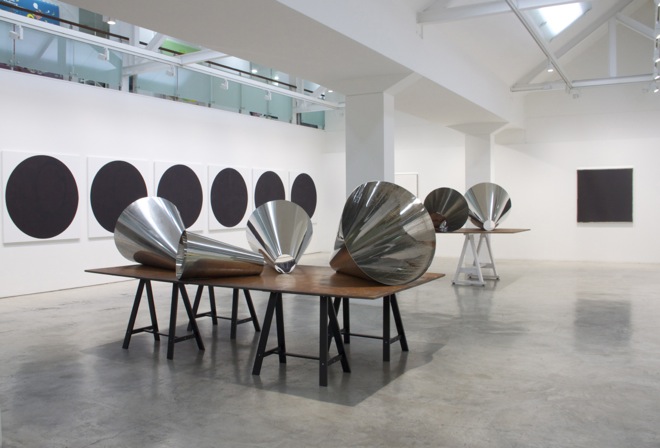
Rirkrit Tiravanija, “Time Traveler’s Chronicle (Doubt): 2014 – 802, 701 A.D.”, installation view, S.T.P.I.
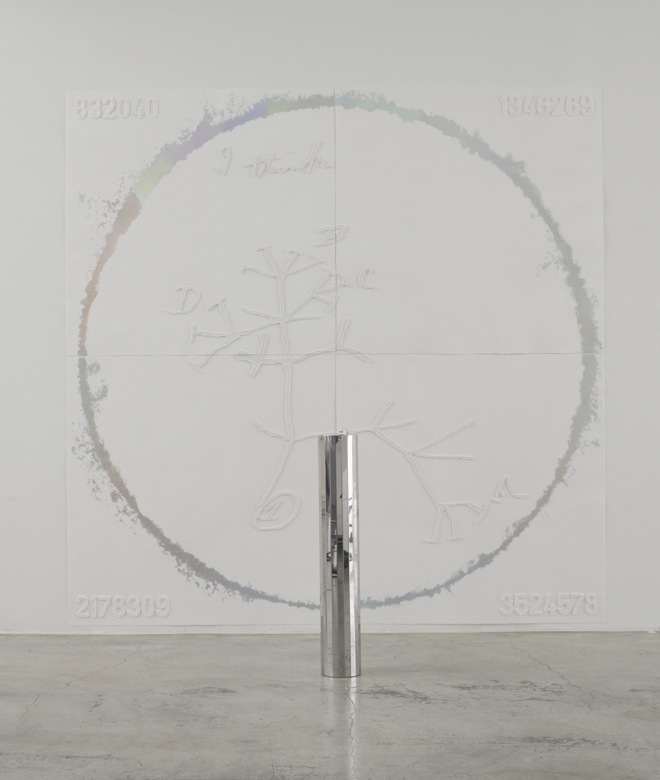
Rirkrit Tiravanija, “Eighth Chapter, return to the unknowing desire, the further one travels the closer one returns (to doubt), Sponge Bob’s the surreal realm of nothingness, he wakes up under the tree, again”, screen print, metal foil, cast paper, STPI handmade cotton paper, stainless steel pedestal, 3D printed object, paper: 269.4 x 269.5 cm (4 sheets), pedestal: 100.5 x 18 x 18 cm, object: 4.5 x 8.5 x 8.5 cm, 2013

